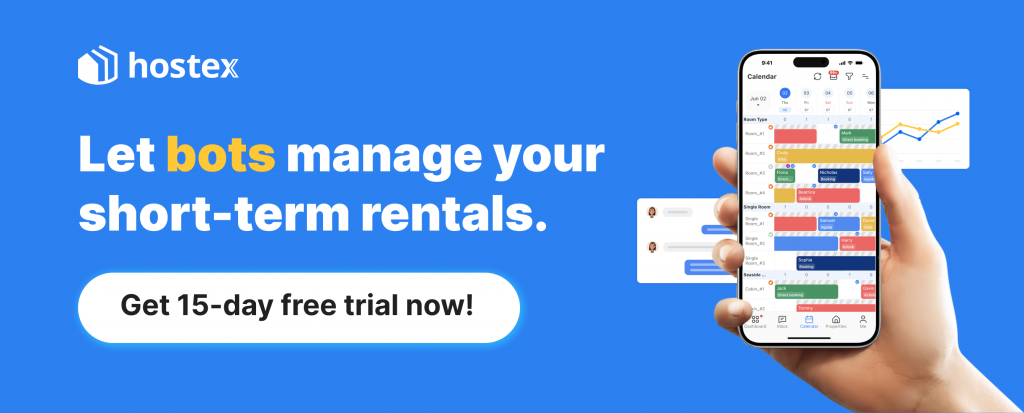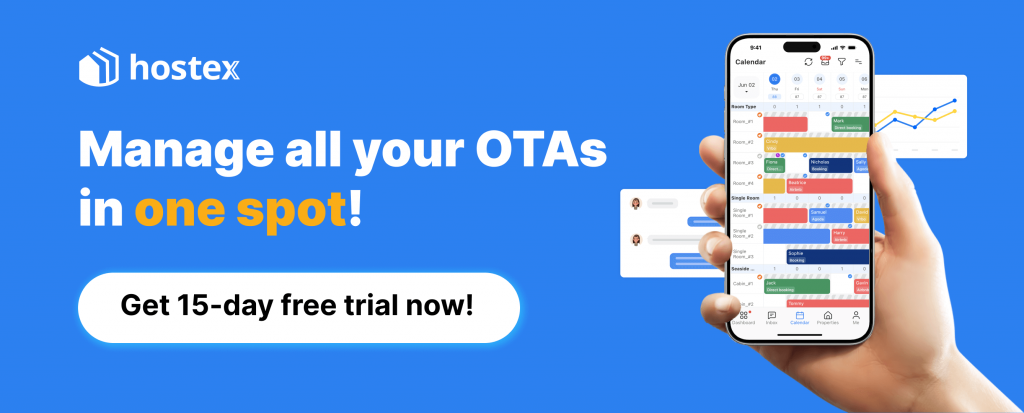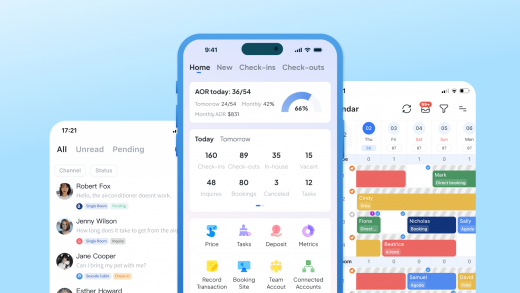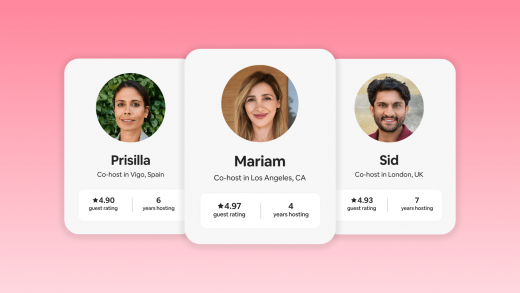Definir o preço certo para o seu aluguel de férias não é apenas uma questão de ganhar dinheiro. É uma questão de mantendo-se competitivo, preenchendo sua agenda, e atrair o tipo de hóspede que você deseja. Uma estratégia bem pensada de precificação de aluguel por temporada pode ajudar você a fazer tudo isso sem precisar adivinhar.
Muitos anfitriões do Airbnb enfrentam dificuldades com preços abaixo do mercado durante a alta temporada ou com tarifas muito altas em períodos de baixa temporada. Como resultado, eles perdem renda potencial ou afugentam viajantes preocupados com o orçamento. Ou seja, os preços podem afetar diretamente tanto a ocupação quanto a receita.
No entanto, com a abordagem e as ferramentas certas, você pode criar um sistema de preços que se ajuste à demanda, à sazonalidade e aos seus objetivos. Neste artigo, exploraremos como criar uma estratégia de preços para aluguel de temporada que ajude você a lucrar mais e, ao mesmo tempo, manter seu aluguel reservado.
Com Hostex, você pode gerencie preços em todas as plataformas OTA em um só lugar. Além disso, a Hostex oferece ferramentas de automação que lidam com mais de 70% de suas operações diárias por apenas $4,9/mês, dando a você mais tempo para se concentrar no que realmente importa.

Por que você precisa de uma estratégia de preços?
Definir o preço do seu aluguel de férias sem uma estratégia clara é como dirigir sem mapa. Você pode seguir em frente, mas não tem controle sobre para onde está indo ou a velocidade com que chegará lá.
Uma estratégia inteligente de preços para aluguel de temporada ajuda você a se manter competitivo, evitar noites vazias e ganhar o que seu imóvel realmente vale. Também oferece flexibilidade para responder às mudanças de estação, eventos locais e à demanda dos hóspedes.
Por exemplo, se você mantiver o mesmo preço o ano todo, corre o risco de perder reservas na baixa temporada ou perder dinheiro na alta temporada. Por outro lado, se seus preços mudam constantemente sem motivo, isso pode confundir os hóspedes e prejudicar a credibilidade do seu anúncio.
Ou seja, precificação não se trata apenas de números. Trata-se de estratégia, consistência e adaptação ao seu mercado.
Mais importante ainda, uma boa estratégia lhe dá confiança. Você não precisará mais adivinhar ou entrar em pânico quando as reservas diminuírem. Em vez disso, você saberá exatamente o que ajustar — e quando.
Fatores-chave que influenciam sua estratégia de preços
Mesmo a melhor estratégia de preços deve ser flexível. Isso porque vários fatores-chave influenciam o que você pode — e deve — cobrar pelo seu aluguel de temporada. Entender esses elementos ajuda você a ajustar os preços de forma inteligente e a se manter competitivo em qualquer situação de mercado.
1. Sazonalidade
As tendências sazonais são uma das maiores influências nos preços dos aluguéis de temporada. A maioria dos destinos tem preços altos e baixos. baixas temporadas, dependendo do clima, férias escolares ou eventos locais.
Por exemplo, propriedades de praia prosperam no verão, enquanto chalés de esqui atingem o pico no inverno. Os preços devem aumentar durante esses períodos de alta demanda e cair durante os períodos de baixa temporada para manter a ocupação.
💡 Dica: Use seu histórico de reservas e calendários de turismo locais para mapear a demanda ao longo do ano.
2. Dia da semana
Os hóspedes geralmente preferem fins de semana para escapadas curtas. Isso significa que as noites de sexta e sábado costumam ter tarifas mais altas. Por outro lado, noites no meio da semana podem precisar de descontos para atrair reservas.
Como resultado, muitos anfitriões bem-sucedidos definem preços variáveis ao longo da semana para aumentar a ocupação e a receita.
3. Eventos e feriados locais
Concertos, festivais, jogos esportivos ou feriados podem aumentar drasticamente a demanda, às vezes até da noite para o dia.
A precificação dinâmica nessas datas permite que você capture esse valor extra. Para esclarecer, perder uma atualização de preços durante um evento local pode significar perder centenas em ganhos potenciais.
4. Prazo de entrega e janela de reserva
A antecedência com que os hóspedes costumam reservar também afeta os preços. Por exemplo:
- Com bastante antecedência, você pode definir tarifas mais altas para viajantes que planejam com antecedência.
- Perto do check-in: ofereça descontos de última hora para preencher lacunas.
Ou seja, entender sua janela típica de reserva ajuda você a definir ajustes de preços oportunos que correspondam ao comportamento dos hóspedes.
5. Duração da estadia
Estadias mais longas reduzem a rotatividade de pessoas e aumentam a estabilidade da ocupação. Oferecer descontos para reservas semanais ou mensais pode atrair nômades digitais ou viajantes com estadias prolongadas.
Por outro lado, você pode cobrar uma diária mais alta para reservas de 1 a 2 noites, especialmente se elas caírem em fins de semana ou feriados.
6. Avaliações e comodidades do seu anúncio
Anúncios melhores podem cobrar mais. Se o seu imóvel tiver avaliações excelentes, Wi-Fi rápido, banheira de hidromassagem ou características únicas (como vista para o mar ou fogueira), você pode justificar preços mais altos.
Mais importante ainda, nunca subestime uma estadia de qualidade. Os hóspedes estão dispostos a pagar mais por conforto, limpeza e uma experiência tranquila.
7. Competição local
Fique de olho no que anúncios semelhantes estão fazendo na sua região. Por exemplo:
- Novos concorrentes estão cobrando menos do que seus preços?
- Outros anfitriões estão oferecendo descontos ou promoções?
- Como suas comodidades se comparam?
Ao observar seu mercado local, você pode adaptar seus preços para permanecer atraente sem correr para o fundo do poço.
8. Taxas e políticas de plataforma
Cada OTA, como Airbnb, Vrbo ou Booking.com, cobra taxas de comissão diferentes e segue políticas de cancelamento e reembolso distintas. Essas taxas de plataforma podem corroer seus lucros, por isso é importante considerá-las na sua estratégia de preços de aluguel por temporada.
Para reduzir a dependência de OTAs, considere criar seu próprio site de reservas diretas. Com Construtor de sites de reservas diretas da Hostex, você pode lançar um site de reservas personalizado sem precisar de nenhuma habilidade de programação e sem taxas extras. Isso significa que você retém mais dos seus ganhos, tem controle total sobre sua política de cancelamento e constrói relacionamentos diretos com os hóspedes.

6 etapas para definir a melhor estratégia de preços para aluguel de temporada
Uma estratégia sólida de precificação de aluguel por temporada não se resume a escolher um número aleatório e torcer para que tudo dê certo. Exige uma estrutura clara, análises regulares e a capacidade de responder às mudanças na dinâmica do mercado.
Aqui está um guia detalhado passo a passo para ajudar você a definir preços que aumentem tanto a ocupação quanto a receita:
1. Calcule seu preço mínimo viável
Antes de obter lucro, você precisa entender seu ponto de equilíbrio. Some todas as suas despesas recorrentes — taxas de limpeza, serviços públicos, manutenção, taxas de plataforma, impostos e hipoteca ou aluguel. Em seguida, considere o tempo que você gasta gerenciando reservas, comunicação com os hóspedes e rotatividade.
Ou seja, o seu preço deve cobrir pelo menos esses custos. Mas, o mais importante, deve refletir o valor do seu tempo e a qualidade do seu imóvel.
💡 Dica profissional: Não se esqueça de despesas ocasionais, como reparos, reformas de móveis ou decoração sazonal. Elas se somam.
2. Pesquise seu mercado local e concorrentes
Vá além de simples comparações. Analise anúncios semelhantes ao seu em localização, tamanho, comodidades e experiência do hóspede. Observe como os preços mudam ao longo do ano. Estão cobrando mais nos fins de semana ou feriados? Cobram taxa de limpeza? Com que antecedência as reservas são feitas?
Veja:
- Tarifas médias por noite por temporada
- Taxas de ocupação para listagens semelhantes
- Períodos de alta demanda (por exemplo, festivais, feriados, férias escolares)
Isso ajuda você a entender o que os hóspedes estão dispostos a pagar e define expectativas realistas.
🔍 Dica de ferramenta: Use plataformas como AirDNA, Mashvisor ou PriceLabs para coletar dados de mercado confiáveis.
3. Segmente seu calendário por períodos de demanda
Divida o ano em baixa, média e alta temporada. Em seguida, identifique datas específicas que geram demanda extra, como festivais locais, feriados ou feriados prolongados. Ajuste seu preço base para cada segmento.
Por exemplo:
- Baixa temporada: Preço base = $90/noite
- Baixa temporada: Preço base = $120/noite
- Alta temporada: Preço base = $160+/noite
- Fins de semana prolongados: preços dinâmicos ou estadias mínimas de 2 a 3 noites
🎯 Ponto-chave: Não trate todos os meses da mesma forma. Os preços devem refletir o comportamento real de viagens e a demanda na sua região.
4. Defina regras de preços e estadias mínimas
Em vez de alterar os preços manualmente a cada vez, crie um sistema de regras. Por exemplo:
- Reduza sua tarifa para reservas de última hora (por exemplo, 20% de desconto para reservas de até 3 dias)
- Aumentar as tarifas para fins de semana de alta demanda
- Adicionar estadias mínimas durante os períodos de pico para reduzir a rotatividade
Essas regras lhe dão controle e ajudam a otimizar seu calendário sem exigir monitoramento constante.
5. Use ferramentas de precificação dinâmicas (mas não confie nelas cegamente)
Software de precificação dinâmica como Laboratórios de preços pode ajustar automaticamente suas tarifas com base na oferta e demanda locais. Essas ferramentas monitoram tarifas de concorrentes, eventos locais e tendências de reservas em tempo real.
No entanto, algoritmos não conseguem ler seu estilo de hospedagem, seus objetivos ou seus instintos. Por exemplo, talvez você prefira priorizar avaliações cinco estrelas em vez de lucro agora, ou talvez esteja buscando estadias mais longas.
Ou seja, essas ferramentas são assistentes poderosos, não tomadores de decisão. Revise as sugestões deles regularmente e faça ajustes com base nos seus insights.
6. Monitore o desempenho e faça ajustes baseados em dados
Depois que seu sistema de precificação estiver implementado, não o configure e esqueça. Fique de olho nas principais métricas:
- Taxa de ocupação
- Taxa média diária (ADR)
- Receita por noite disponível (RevPAN)
- Prazo de entrega (com que antecedência os hóspedes reservam)
Se a sua agenda estiver lotada muito rápido, suas tarifas podem estar muito baixas. Se estiver vazia durante a alta temporada, você pode estar com preços altos ou não estar oferecendo o valor desejado. Use padrões de reserva para refinar sua estratégia.

Ferramentas eficazes para precificação de aluguel de férias
A precificação dinâmica é uma abordagem simples e eficaz para ajustar suas tarifas com base nas condições de mercado, mas muitos anfitriões de aluguéis por temporada enfrentam um dilema comum: "Isso significa que preciso alterar meu preço todos os dias? E se eu tiver vários anúncios em plataformas diferentes?"
De fato, atualizar manualmente cada preço seria uma tarefa assustadora, senão impossível. No entanto, com as ferramentas e a abordagem certas, a gestão de preços pode ser fácil.
Com Hostex, seu sistema de gestão de aluguer de curta duração permite que você gerencie preços em diversas plataformas com apenas alguns cliques. Você pode ajustar as tarifas com eficiência, com base na sua estratégia de preços de aluguel por temporada, sem o estresse de atualizar cada anúncio manualmente.
1. Ajustes de preços em massa em vários anúncios
Seja você um único imóvel ou vários anúncios, a Hostex permite selecionar tipos de quarto ou imóveis específicos e aplicar as alterações em massa. Você pode atualizar as tarifas em várias plataformas simultaneamente, economizando horas de trabalho.
- Ajuste os preços para vários quartos ou tipos de propriedade em uma única ação
- Modifique rapidamente os preços para intervalos de datas ou feriados específicos
- Defina taxas de preços para cada plataforma para garantir consistência em todos os canais
Isso permite que você mantenha o controle sobre seus preços sem ficar sobrecarregado com alterações manuais.
2. Ajustes rápidos por porcentagem ou taxa fixa
Com a Hostex, você pode ajustar rapidamente as tarifas com base em uma porcentagem ou uma taxa fixa.
Por exemplo, se você quiser aumentar sua diária em 10% para um feriado que se aproxima, pode fazê-lo em apenas alguns cliques. Isso lhe dá a flexibilidade de responder às mudanças nas condições do mercado em tempo real.
3. Integração com ferramentas de precificação dinâmica
Para aqueles que preferem uma abordagem mais prática em relação aos preços, a Hostex também se integra com ferramentas de preços dinâmicos como Laboratórios de preços, que ajustam automaticamente suas taxas com base em dados em tempo real do seu mercado.
Essas ferramentas monitoram os preços dos concorrentes, os níveis de demanda e os eventos locais, e ajustam suas tarifas de acordo, garantindo que você esteja sempre oferecendo preços competitivos. No entanto, é importante revisar essas alterações periodicamente para garantir que estejam alinhadas aos seus objetivos.

Perguntas frequentes sobre estratégias de preços para aluguel de férias
Quando se trata de precificação de aluguéis de temporada, os anfitriões costumam ter diversas dúvidas comuns. Essas perguntas destacam os desafios e as considerações envolvidas no desenvolvimento de uma estratégia de precificação eficaz. Abaixo, algumas das perguntas mais frequentes e suas respectivas respostas.
1. Com que frequência devo atualizar o preço do meu aluguel de férias?
Embora seja importante ajustar os preços regularmente, a frequência com que você atualiza suas tarifas depende do seu mercado e das ferramentas que você tem à disposição. Em geral, ferramentas de precificação dinâmica e sistemas de precificação automatizados podem facilitar muito esse processo.
Por exemplo, se você usar uma ferramenta de precificação dinâmica como Laboratórios de preços Com os recursos de ajuste de preços em massa da Hostex, você pode precisar revisar e ajustar seus preços apenas uma vez por semana ou após grandes eventos locais. Em temporadas de alta demanda, no entanto, você pode querer ajustar suas tarifas com mais frequência, especialmente se suas reservas estiverem chegando rapidamente.
2. Como defino o preço do meu aluguel de férias para ocupação máxima?
Maximizar a ocupação não se trata apenas de baixar os preços, mas também de encontrar o equilíbrio certo. Definir um preço muito baixo pode prejudicar sua receita, enquanto definir um preço muito alto pode resultar em menos reservas. O segredo é monitorar regularmente o mercado local e os preços dos concorrentes.
Para maximizar a ocupação, considere oferecer descontos para estadias mais longas ou ajustar seus preços de acordo com os padrões de demanda. Use ferramentas como a Hostex para automatizar esses ajustes e acompanhar os resultados ao longo do tempo para refinar sua estratégia de preços.
3. Devo oferecer descontos para reservas de última hora?
Oferecer descontos para reservas de última hora pode ser uma ótima maneira de preencher vagas, mas tome cuidado para não desvalorizar seu imóvel. Você pode configurar descontos ou reduções automáticas de preço conforme a data de check-in se aproxima, permitindo que você preencha as lacunas sem reduzir drasticamente as tarifas.
Por outro lado, não reduza suas tarifas só porque seu imóvel está vazio. Uma estratégia bem pensada pode ajudar você a evitar preços abaixo do mercado e, ao mesmo tempo, atrair hóspedes de última hora.
4. Como posso ajustar o preço do meu aluguel de férias para eventos especiais?
Eventos especiais, como shows, festivais ou grandes jogos esportivos, podem causar um pico na demanda. É essencial ajustar os preços desses eventos para capitalizar o aumento do interesse.
Para fazer isso de forma eficaz, acompanhe eventos locais na sua região e defina sua estratégia de preços com antecedência. A Hostex pode ajudar você a gerenciar aumentos de preços baseados em eventos e garantir que você não perca a oportunidade de maximizar sua receita durante os horários de pico.
5. Como posso competir com outros anúncios de aluguel de férias?
Manter-se competitivo exige um monitoramento constante do seu mercado local. Acompanhe os preços dos seus concorrentes, as comodidades que oferecem e a qualidade dos seus anúncios. Ao usar a precificação dinâmica e ajustar seus preços com base nesses fatores, você pode permanecer competitivo sem inflar preços.
Além disso, oferecer recursos exclusivos, serviço excelente e avaliações excelentes ajudará você a se destacar da concorrência, mesmo que seu preço não seja o mais baixo.
6. Como equilibrar ocupação com lucratividade?
Maximizar a ocupação e, ao mesmo tempo, garantir a lucratividade pode ser complicado. Muitos anfitriões cometem o erro de focar apenas nas taxas de ocupação, o que pode resultar em oportunidades perdidas de receita. O objetivo deve ser aumentar tanto a ocupação quanto a receita. Isso significa definir o preço certo com base na demanda, sazonalidade e tarifas da concorrência.
Use ferramentas como Hostex para ajustar seus preços de acordo com as tendências de mercado e o comportamento dos hóspedes, e garantir que você encontre o equilíbrio perfeito entre ocupação e lucratividade.
7. Posso usar uma única estratégia de preços para todas as minhas propriedades?
Se você gerencia vários imóveis para aluguel por temporada, pode se sentir tentado a usar uma única estratégia de precificação para todos. Embora isso possa funcionar em alguns casos, é importante lembrar que cada imóvel pode ter fatores únicos que afetam seu preço.
Por exemplo, um imóvel de luxo em uma área de alta demanda provavelmente terá preços mais altos do que uma unidade menor em um bairro menos popular. Hostex, você pode adaptar sua estratégia de preços para cada propriedade e ajustar automaticamente os preços em diferentes OTAs, economizando tempo e maximizando sua receita.
Definir o preço do seu aluguel de férias é mais do que apenas definir uma diária. Envolve entender as tendências de mercado, a concorrência e as diversas ferramentas que podem facilitar os ajustes de preços. Desenvolvendo uma estratégia de preços dinâmica e utilizando ferramentas inteligentes como Hostex, você pode otimizar seu processo de precificação e garantir que seu imóvel sempre tenha um preço para ocupação e lucratividade máximas.



